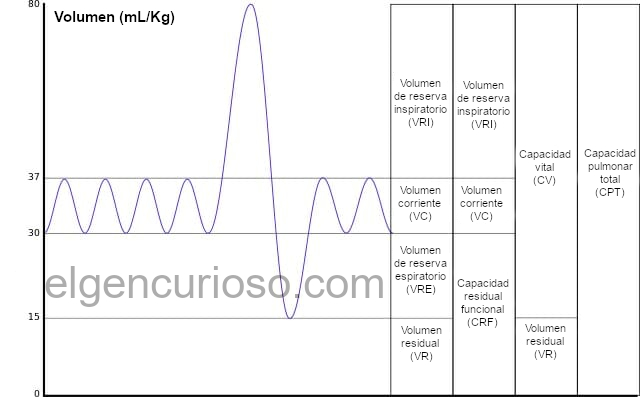Definition of vital capacity
Vital capacity is the amount of air that can be expelled from the lungs after they have been completely filled. Vital capacity represents the change in volume from completely empty lungs to completely full lungs. In human medicine, vital capacity is an important measure of a person’s respiratory health. A healthy adult will have a vital capacity between 2 and 5 litres.
A severely diminished vital capacity is an indication of restrictive lung diseasein which the lungs cannot expand fully. If the vital capacity is normal, but the lungs still do not function properly, this could be an indication of obstructive pulmonary diseasein which the lungs are obstructed or blocked in the airways.
Vital capacity can be measured with the use of a spirometer which can also separate the different components of the vital capacity. As seen in the following spirometer, the vital capacity consists of the expiratory reserve volumethe tidal volume and the inspiratory reserve volume. Inspiratory and expiratory reserve volumes are the volumes of air drawn in and exhaled above and beyond normal breaths, while tidal volume represents the standard low-volume breath.

Vital capacity formula
There are two formulas for vital capacity, depending on the sex of the subject. In the following two formulas, H represents the height in centimetres, while A represents the age of a person in years.
Female:
VITAL CAPACITY = (21.78 – 0.101A) XH
Male:
VITAL CAPACITY = (27.63 – 0.112A) XH
Vital capacity is typically measured in cubic centimetres, a measure of volume. These formulas simply show the average vital capacity for a man or woman of a specific age and sex.
For example, a 35-year-old woman who is 160 cm tall should have the following vital capacity:
Vital capacity = (21,78 – 0,101 (35)) x 160
Vital capacity = 2,919.2
If a female blows into a spirometer and she only has a vital capacity of 2,000 cm3 would be an indication that something was wrong with their lungs, as they cannot expand fully. Many different diseases, conditions and genetic conditions can cause a decrease in vital capacity.
- Tidal volume: The volume of air that is inhaled and exhaled during normal breaths.
- Expiratory reserve volume: The extra volume of air that can be expelled from the lungs when forced.
- Inspiratory reserve volume: an additional amount of air that can be inhaled, which increases lung capacity.
- Residual volume: the amount of air that cannot be expelled from the lungs, which prevents them from collapsing.
